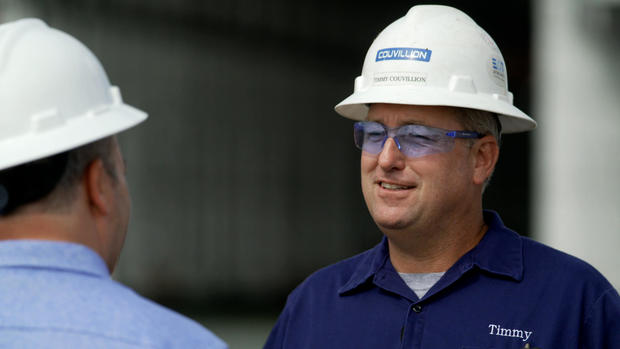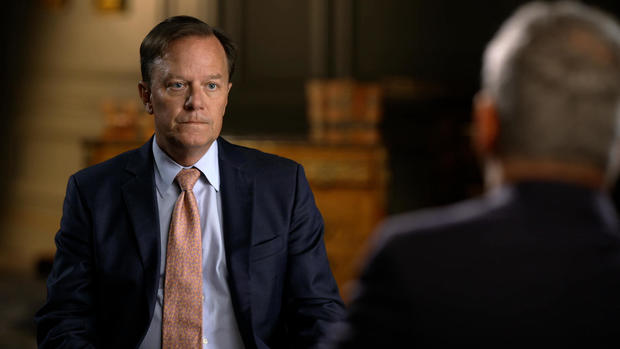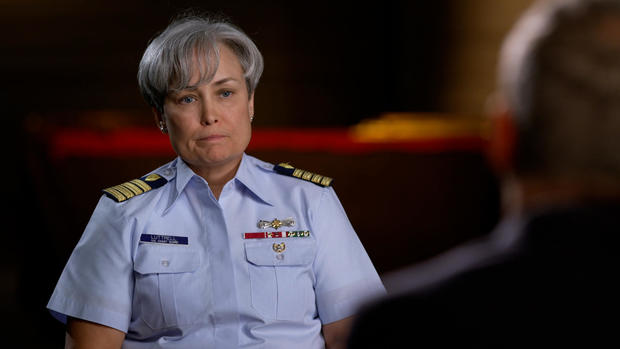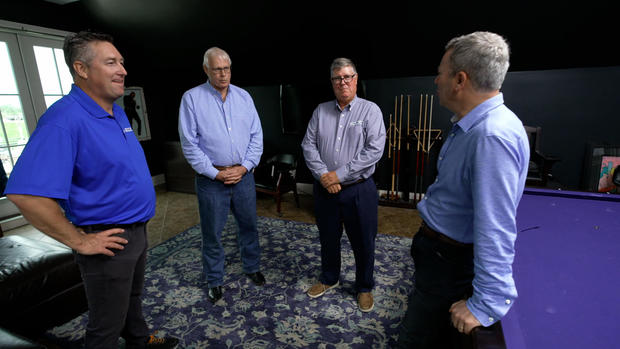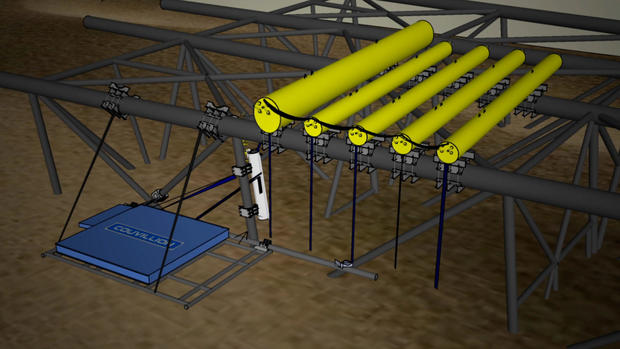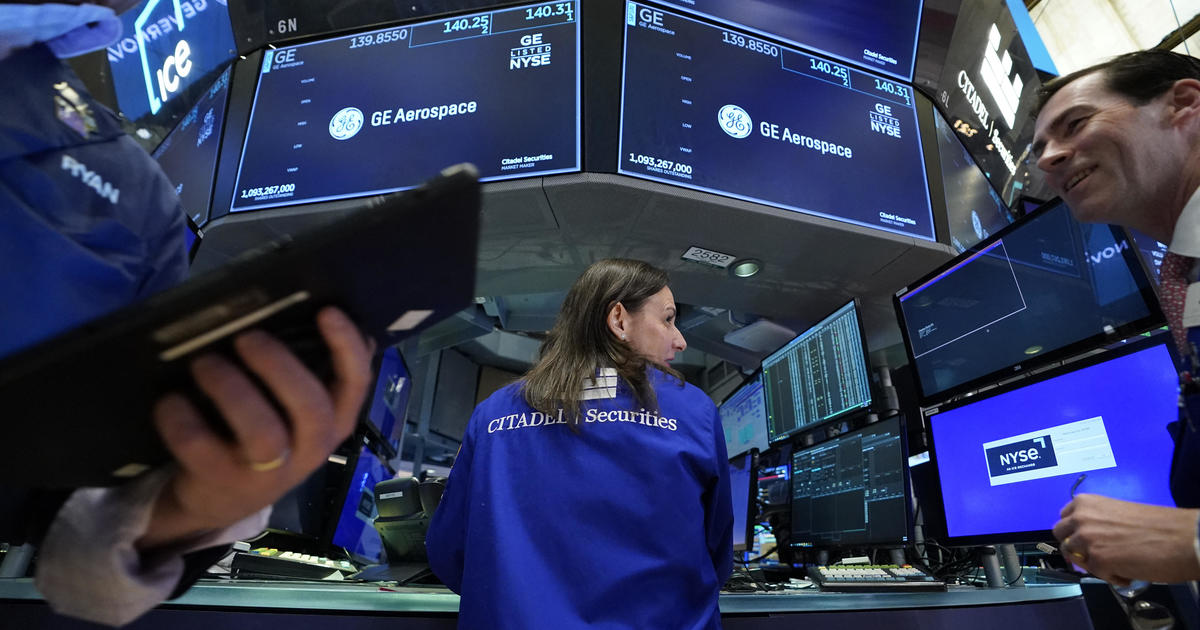Taylor Energy Oil Spill: Stanching the longest-running oil spill you've likely never heard of
The hurricanes keep coming –with increased force and increased frequency. Even before hitting land, they're often wreaking havoc. Katrina, Sandy, Ida —name a tropical storm and odds are good it's caused an off-shore oil spill. And these messes aren't easily cleaned up.
Tonight, we bring you a distinctly Louisiana story, one we first reported last November, the saga of the Taylor Energy Oil Spill, a storm-caused, environmental crisis that's sullied the Gulf of Mexico since 2004. Then, along came an unlikely duo: a no-nonsense Coast Guard captain who said enough is enough, and a homegrown Cajun engineer who brought with him the power of local knowledge. Together they would resist a deep-pocketed energy company… and help stanch the longest-running oil spill in U.S. history.
Jon Wertheim: How many miles offshore are we now?
Timmy Couvillion: We're about 12 miles offshore from the coast of Louisiana.
A seventh-generation Cajun, Timmy Couvillion grew up on the Louisiana Delta, where river mingles with sea. Even as an engineering student, he moonlighted as a fishing captain.
Timmy Couvillion: I've caught, you know, 150-pound tunas this close.
He showed us the precise site of a ground-breaking contraption that's consumed him lately.
Jon Wertheim: We're right above it now, aren't we?
Timmy Couvillion: Yes, sir. The Taylor Energy platform would be laying on its side just below us.
His engineering company has conceived of and installed a system to help contain a stubborn oil spill. It's directly below a spot, nearly 500 feet underwater.
Timmy Couvillion: If we didn't have GPS coordinates, we wouldn't know that we had a functioning system that was actively collecting 1,000 gallons of oil a day.
Catch that? An average of 1,000 gallons of oil a day that would otherwise be contaminating the Gulf of Mexico. It's being captured by Timmy Couvillion's system and transferred to these tanks to be sold later as recycled oil.
Timmy Couvillion: A hundred thousand gallons is a major oil spill. This is seven major oil spills that we've collected since April of 2019.
Jon Wertheim: How many years you been doing this?
Timmy Couvillion: Two years.
The mouth of the Mississippi forms the heart of Louisiana commerce. This region is nourished by a mix of fish, water, gas and oil. But increasingly, both the terrain and the economy are getting beaten up by mother nature.
In 2004, Hurricane Ivan devastated the Gulf, including bringing down a massive oil platform operated by Taylor Energy. Couvillion made a video simulation of what likely happened.
Timmy Couvillion: To see the energy that it took to shear the legs of this eight-pile platform, the Taylor Energy platform it's hard to comprehend.
The underwater mudslide toppled the oil platform, damaging the connections to as many as 28 oil wells below. To this day, the structure lies horizontally on the floor of the Gulf.
The sheen caused by the oil spill spread for miles. For years, ships traveling through were coated in the slick. Pools of oil bubbled up to the surface and marine life, like these schools of giant amberjack, had to swim through the muck.
How could this spill have gone on for 17 years and counting without much public awareness? For one, Taylor Energy is not a Fortune 500 giant, but a local company; and a beloved one at that.
Jon Wertheim: For people not from here, who are the Taylors of Taylor Energy?
Pat McShane: This is a family which has built its reputation as a benevolent community corporate citizen of the highest order.
Pat McShane is a prominent Louisiana maritime lawyer, whose clients include Timmy Couvillion. He says that in New Orleans society, the Taylors are known for their educational philanthropy.
Pat Taylor on 60 Minutes in 1989: How ya doing, man. I'm Pat Taylor. Nice seeing you. How y'all been?
In 1989, 60 Minutes reported on the Taylors' generosity. When the spill occurred, locals assumed the Taylors would clean it up.
Pat McShane: Taylor has been tasked under the Federal Oil Pollution Act with the responsibility for containing the oil and coming up with a permanent solution. And during that time they worked hand and glove with the United States government.
The U.S. government makes money -- billions, in fact -- leasing off-shore oil rights. So, when there is an oil spill, the government has ultimate authority. But we were surprised to learn how much the government relies on the leasing oil companies themselves to lead the recovery efforts.
Jon Wertheim: People might hear the story and say, "Wait a second. It's up to the oil companies to give the estimate how severe this is?"
Kristi Luttrell: It is. And in general, the industry's very responsible in reporting those type of amounts and even cleaning up the-- the spill and securing the source.
Captain Kristi Luttrell, a veteran of the coast guard, was placed in charge of overseeing the taylor energy spill in 2018.
Kristi Luttrell: This is the biggest pollution response case I'll see in my 28-year career.
Taylor Energy was required by federal law to set aside $666 million in a trust to fund cleanup costs. Taylor says that by 2011, it had spent hundreds of millions to plug nine of the most active wells at the site.
Then in 2013, Taylor Energy, along with U.S. government agencies, including the Coast Guard, issued this report concluding the best option was to leave the underwater site alone. It said only small amounts of oil - "about three gallons per day" - were likely flowing; and further action could hurt the environment.
Jon Wertheim: For years they were claiming this was about three gallons a day, not 1,000, three gallons a day that was seeping out.
Kristi Luttrell: I honestly could not speak for their opinions on their science.
But measuring oil spills deep underwater is difficult. And estimates varied wildly depending on the source of the data. Captain Luttrell says that by 2018, the Coast Guard had access to improved sonar revealing that oil was still escaping; a lot of it.
Kristi Luttrell: We believe there's multiple wells still leaking inside the erosional pit at the site.
Jon Wertheim: At what point did you say, "You know what? Enough. The Coast Guard's gonna take over this containment?"
Kristi Luttrell: I came to that decision sometime in late summer of 2018. It didn't take me long to realize that we were gonna go ahead and have to federalize this case when I didn't feel like I was getting a timely response out of the responsible party.
Luttrell says she was concerned that Taylor Energy was, in her words, "not acting in a timely manner." And she took over control of the containment, putting out a call for bids for a temporary solution to collect any flowing oil. Timmy Couvillion's Louisiana firm competed with other engineering contractors to come up with an invention.
Jack Couch: I've worked with Timmy at Oceaneering…
Couvillion summoned two friends, former colleagues. They began with a basic concept: oil and water don't mix.
Jack Couch: I had invented the underwater separator.
Jack Couch is a longtime expert deep sea diver; Dr. Kevin Kennelley, aka Dr. K, is an engineer. The three amigos, they called themselves, hunkered down in Timmy Couvillion's man cave in Belle Chasse, Louisiana, taking breaks only to shoot pool and eat po' boys.
Jon Wertheim: Take me back to when you guys were using this room to solve problems.
Dr. Kevin Kennelley: Well, I remember Jack sat there. Timmy sat there. And I sat over here. We each had a desk.
It took the three amigos five days before, as they put it, they went "from can't to can."
Jack Couch: There was even no moving parts. There's no pumps, no nothing. We just used the natural buoyancy of the fluids and stuff.
Timmy Couvillion: I looked at them and I'm like, "Is there any reason why this won't work?"
They even tested their invention in the backyard pool.
Dr. Kevin Kennelley: We did everything from test it in-- a swimming pool to full scale tests in-- in very, very large tanks to make sure that it worked.
Against steep competition, their proposal was chosen by the Coast Guard in late 2018. The blue box would act like a cap which collects the leaking oil and gas; that would get separated in the white tank; and then the oil would go to storage in the yellow tubes. From there it would be pumped off to a ship each month, but Couvillion had to make the concept a reality—and the clock was ticking.
Timmy Couvillion: It was about December-- December 15th-- we were onsite with our ROVs, which is a remotely operated vehicle, so an underwater robot.
Couvillion's team dropped the ROV to get detailed sonar images of what was going on 470 feet down. He says he was shocked by what he saw in his images: the red represents plumes of oil and gas spewing in front of the downed platform.
Jon Wertheim: This is what you're seeing after you have the contract.
Timmy Couvillion: That's right. My first reaction was, "This isn't micron droplets that's comin' out from the sea floor, this is an underwater volcano."
Couvillion's crew put more than 200 tons of steel pieces together using enormous cranes, teams of expert sea divers and multiple remote operated vehicles. To get a sense of proportion, note the size of the men compared to the equipment.
Kristi Luttrell: I did not sleep very well those nights that I knew the divers were out and about on the seafloor in almost 500 feet of water. And I was concerned about the crane failing and that much weight dropping.
Spring of 2019 brought the moment of truth. This wasn't testing a simulation in a backyard pool. This was the real thing - a $43 million system - in the Gulf.
Timmy Couvillion: When we opened up the valves and less than a day later, the sheen had largely disappeared, we knew we had really done something. It was awesome.
Jon Wertheim: A good day for the environment?
Timmy Couvillion: Oh, no doubt. Look, nobody wants oil in their backyard, right? We proved that-- we can clean up our mess, right?
Jon Wertheim: You send it 500 feet down and dang, it's working.
Kristi Luttrell: It was simple, yet effective. And I give the engineers credit for coming up with that design.
But like the muddy Mississippi itself, this tale has no clear endpoint.
Taylor Energy headed straight to court. In total it's filed more than ten separate suits in conjunction with the oil spill, including one against couvillion. The claim: he was trespassing and was negligent. Taylor's lawyer also told the court:
"We very much dispute that these activities need to be going [on] out there at this point in time or that this is even Taylor Energy oil out there at this point in time."
In response, Couvillion's maritime lawyer, Pat McShane, characterized Taylor's allegations as "pernicious." And he pointed us to a wealth of evidence indicating that the oil was indeed Taylor's.
Pat McShane: The National Oceanic Atmospheric Administration, the United States Coast Guard have taken all manner of visual evidence of the plumes coming out of the seabed right at the platform. When you say, "That's not our oil," against this overwhelming evidence, you're playin' some different kind of game.
Couvillion, a former Louisiana state wrestling champion, says he's not backing down from the fight.
Jon Wertheim: You're working to fix a problem that an oil company was responsible for and now they're suing you?
Timmy Couvillion: Kinda crazy, isn't it? It's intimidation by litigation.
Taylor Energy also filed legal action against Captain Kristi Luttrell, arguing that she overstepped her Coast Guard authority.
Jon Wertheim: You've been named personally. How do you perceive this situation?
Kristi Luttrell: As the federal on-scene coordinator I used my authority to do the right thing and to protect the environment.
Phyllis Taylor - CEO of Taylor Energy - declined our interview request. The company said in a statement that it, "...has retained and relied upon the world's foremost experts to study and then recommend a plan of action... We continue to advocate for a response driven by science."
Taylor lost its case against Couvillion and an action to recover the $432 million still left in that clean-up trust. 60 Minutes has learned that Taylor is now in mediation with the government to conclude all the outstanding litigation at once. Asked why he thinks Taylor resisted so intensely, Timmy Couvillion doesn't hesitate.
Timmy Couvillion: That's the $432 million question. You know, in this case-- it seems like if you follow the money, you'd have a better chance of getting your answer.
Jon Wertheim: What would you say to Phyllis Taylor, if she were sitting right here?
Timmy Couvillion: I'd just want to know why? Why are we at this point? Someone that has given so much to our state, why would you continue to allow this oil spill to happen in our Gulf waters?
The federal government says that some of the oil wells buried in the mud still need to be sealed permanently. Meanwhile, Couvillion's system plugs away, so to speak. As of this past week, it's captured more than 800,000 gallons of spilled oil.
After our story first aired, Taylor Energy dissolved as a company, settling all remaining cases, agreeing to hand over $475 million to the federal government for clean up and penalties. Couvillion's system is still plugging away. As of this spring, it's captured more than one million gallons of spilled oil.
Produced by Oriana Zill de Granados. Associate producers, Emily Gordon and Tadd J. Lascari. Broadcast associate, Elizabeth Germino. Edited by Matthew Lev.
